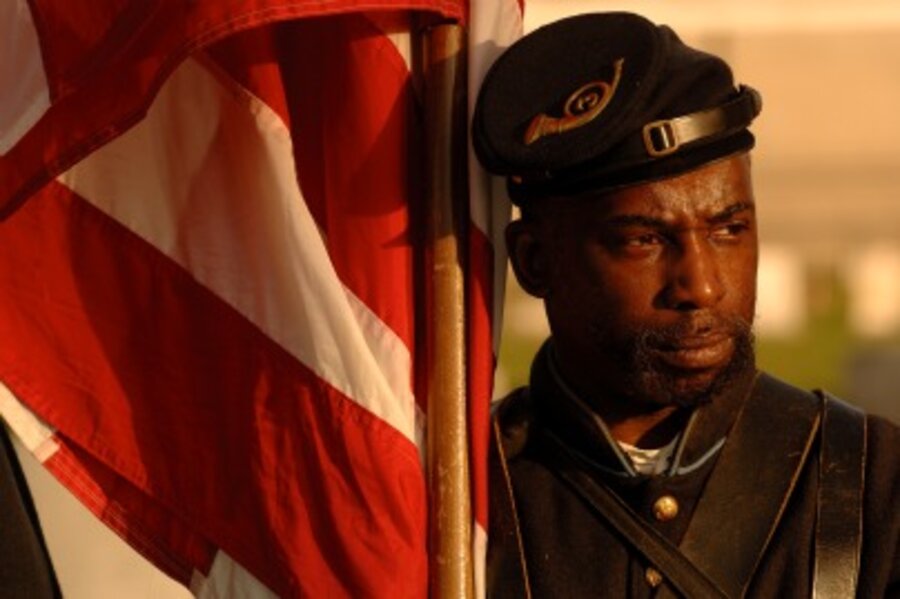Will the Civil War speak to America again?
Loading...
Nov. 6 marks 150 years since Americans elected a little-known lawyer from Illinois as president of the United States.
The anniversary of Abraham Lincoln’s victory also serves as the informal kickoff to the sesquicentennial of the Civil War. Ahead lie five years of commemorations, from the firing on Fort Sumter that began the conflict (April 2011) to the Emancipation Proclamation freeing slaves in the Confederate states (January 2013) to the military turning point (Gettysburg, July 2013) to Lee’s surrender at Appomattox Court House and Lincoln’s assassination (April 2015).
Shiloh. Antietam. Fredericksburg. The battle of the ironclad ships, Monitor and Merrimac. Union naval officer David Farragut urging "Damn the torpedoes, full speed ahead!" And much more. It all lies ahead – as Americans revisit the greatest national crisis since the founding of the United States, what some call “the second American revolution.”
How lasting has been the impact of the Civil War? “... [W]e are destined to reckon with the Civil War as long as we are Americans,” notes one contemporary observer.
How will Americans mark the event, which cost at least 600,000 American combat deaths out of a US population of 31 million, which included at the war's beginning some 4 million slaves?
Ken Burns’s monumental 1990 TV documentary series "The Civil War" will be dusted off by fans and, one hopes, fascinate a new generation of viewers.
States and cities, especially in the Southeastern US where most of the fighting took place, will hope to see a tourism boom as Americans look for themselves at the places where these events that forever changed US history took place. Gettysburg, Pa., expects to host an additional 1 million visitors in 2013, for a total of 4 million during that year.
Several years ago my wife and I finally made a pilgrimage to Gettysburg. We splurged and hired a licensed guide to personally show us around the battlefield. We explored the rolling terrain, from both the Union and Confederate perspectives. Preservation efforts have kept it looking much the way it did then: Little Round Top, Devil’s Den, Seminary Ridge, Pickett’s charge, the Angle. Those names mean so much more when you stand on the ground where the blood was spilled.
It’s hard to predict now what aspects of this long-ago conflict will resonate most with Americans in the second decade of the 21st century. But two early contenders stand out.
Historians and political scientists are already wrestling with the question of how today’s political climate echoes those times. No one sees states seceding from the union. But are Tea Party activists akin to the Southern secessionists, angry citizens who see an oppressive federal government forcing its will (and taxes) on them? Or are they the next Republican Party, which broke onto a political scene dominated by Whigs and Democrats and elected one of its own as president (Lincoln) in 1860 on only its second try? That election realigned the nations political system into the two major parties, Republicans and Democrats, that remain today.
Political mud-slinging and hyperbolic name-calling in this year's midterm elections has nothing on the campaign of 1860, though the Internet may let the dirt fly farther and faster than in 1860. Below is a description of how Lincoln was attacked by his opponents, according to his biography at The University of Virginia's Miller Center of Public Affairs, which studies the history of the US presidency. It's ironic since today Lincoln is more likely to be criticized for moving too slowly, rather than too quickly, toward emancipation of Southern slaves.
His opponents countered by making fun of Lincoln's limited experience as a statesman and his "slang-whanging stump speaker" style, which they said reflected a limited intellect that would be an embarrassment to the nation should he be elected President. The Charleston Mercury ridiculed his looks, depicting him as a "horrid looking wretch . . ." unfit for office. Cartoons showed Lincoln dancing with black women and championing "amalgamation" and "miscegenation" (mixing of the races). One widely distributed picture showed Lincoln steering a ship with a thick-lipped black man embracing a young white girl sitting at his feet on deck. Other pictures were much cruder and even more blatantly racist, of a type never before so prevalent in a national election. One secessionist in Georgia warned that Lincoln planned to force the inter-marriage of black and white children, and that within "ten years or less our children will be the slaves of Negroes."
Exactly what role slavery played in causing and determining the outcome of the War is the source of historical debate. But the war clearly led to the 15th amendment to the Constitution, extending voting rights to all (male) citizens, regardless of race. And it started a debate on the state of race relations that may heat up again as the injustices of those times are recalled.
“The consequences of the Civil War are still with us even today. We’re still talking about race, we’re still talking about inclusivity, we’re still talking about diversity,” notes Hermina Glass-Avery, associate director of the Center for the Study for the Civil War era at Kennesaw (Ga.) State University.
Does race really still matter? In what ways? Perhaps those will be the questions from the 1860s that most resonate today.





